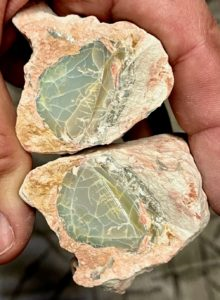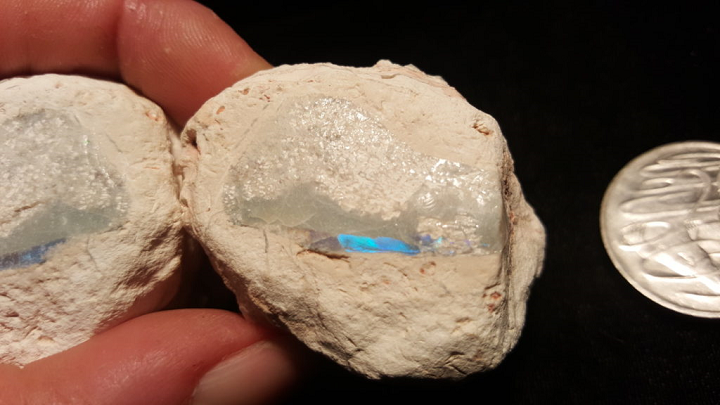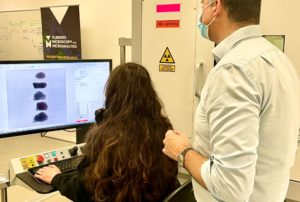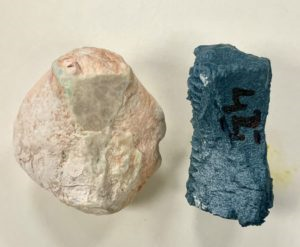In order to get a closer look at, and learn more about creatures that died long ago, like dinosaurs, researchers and historians have turned to 3D printing and 3D scanning methods many times. The technologies have even helped reveal the discovery of a new species, like in the recent case of a small dinosaur that’s been preserved as opal in white sandstone rocks for over 100 million years. This opalized fossil is pretty rare, and paleontologists are using a micro-CT scanner at Flinders University, Tonsley in Adelaide, Australia, along with 3D printing, to study and reconstruct the dinosaur inside, and perhaps even discover a new species while they’re at it.
Researchers have determined that the fossilized dinosaur, found in Lightning Ridge, New South Wales, lived in forests not far from an inland sea, and is a plant-eating hypsilophodont—in layman’s terms, a small, running herbivore. According to the Palaeo Pictures documentary team, led by Flinders Associate Professor “Palaeo Paul” Willis, two miners found the fossil while they were searching for opal, which is Australia’s national gemstone; in fact, the country is said to be the world’s leading source of gem-quality opal. While opal miners find these opalized fossil shells often, they’re not seen as much in the rest of the world, and are chock full of important scientific data.

The bones are preserved as common opal, or potch, and are mostly embedded within a white sandstone. Photo courtesy Palaeo Pictures
This particular fossil was saved for scientific purposes back in 2019. Lightning Ridge fossils are often preserved as colorless, valueless potch (common opal), though some are made of precious opal, which is obviously high in value. But all of them are historically and scientifically priceless to paleontologists, so study is imperative to understand more about the ancient creatures inside these fossils.
Associate Professor Willis, from the university’s College of Science and Engineering Paleontology Lab, said, “We’re using the Flinders CT Scanning Facility at Tonsley to look inside lumps of rock that contain the remains of a small dinosaur.
“Once we have reconstructed the scans into 3D virtual models, we can print them out with a 3D printer so we can see the bones still hidden inside the rock.”
Once CT scanning and 3D printing are complete, the reconstructed dinosaur will be “salvaged and revived” so that other researchers, and future generations, can see it for themselves.
“Not only do the scans allow us to better understand exactly what we have as a dinosaur skeleton, they will be an invaluable aid to the next stage of studying this specimen, by removing the surrounding rock,” explained Associate Professor Willis, who is the lead researcher for the university team. “Prior to using scans on specimens like this, the removal of surrounding rock was very much a case of ‘doing in blind’, feeling our way in to reveal the bones. Now we can do that with more confidence because we know where the rock stops and the bone starts.”
The university researchers are working on the fossilized dinosaur reconstruction together with Palaeo Pictures and the Australian Opal Centre, a national museum in the opal mining town of Lightning Ridge to “preserve, display and research the greatest ever public collection” of Australian opal and opalized fossils. Only about 20% of the specimens have been scanned, so there’s still a long way to go, but recent scans of some of the pieces show that the bone inside the fossil has been preserved in extremely high detail.
Associate Professor Willis says the team has already started 3D printing some of the most interesting specimens. Once micro-CT scanning is complete, the scan data will be used to help with a detailed study of the skeleton. Then, the team will be able to determine how it lived and died, as well as if it is actually a new species of dinosaur.

Section through a bone of the new opalised dinosaur fossil showing the play of colour of precious opal.
Photo: J. Brammall / Australian Opal Centre
Subscribe to Our Email Newsletter
Stay up-to-date on all the latest news from the 3D printing industry and receive information and offers from third party vendors.
You May Also Like
Gorilla Sports GE’s First 3D Printed Titanium Cast
How do you help a gorilla with a broken arm? Sounds like the start of a bad joke a zookeeper might tell, but it’s an actual dilemma recently faced by...
Nylon 3D Printed Parts Made More Functional with Coatings & Colors
Parts 3D printed from polyamide (PA, Nylon) 12 using powder bed fusion (PBF) are a mainstay in the additive manufacturing (AM) industry. While post-finishing processes have improved the porosity of...
$25M to Back Sintavia’s Largest Expansion of Metal 3D Printing Capacity Since 2019
Sintavia, the digital manufacturing company specializing in mission-critical parts for strategic sectors, announced a $25 million investment to increase its production capacity, the largest expansion to its operations since 2019....
Velo3D Initiates Public Offering in a Bid to Strengthen Financial Foundations and Drive Future Growth
Velo3D (NYSE: VLD) has been among a number of publicly traded 3D printing firms that have attempted to weather the current macroeconomic climate. After posting a challenging financial report for 2023,...



































